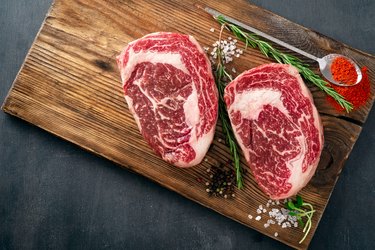
The difference between good beef and great beef is sometimes due to the qualities of the animal itself. More often, however, the difference is because of how that beef is handled after slaughter.
Most modern beef is wet-aged, an economical and cost-effective process. However, the best beef is dry aged in the traditional fashion. Although some work is involved, any food lover can dry-age a prime cut such as ribeye at home in the fridge.
Video of the Day
Video of the Day
Dry Aging the Ribeye
- For dry aging, use a flat, leakproof container or tray to hold the roast.
- Place a wire rack on the bottom, to allow airflow beneath the beef.
- Pat the roast dry with paper towels and center it on the rack.
- Cover the exposed surfaces with cheesecloth or freshly laundered kitchen towels.
- Clear a space in your refrigerator, and place the roast inside.
- Let it age for 3 to 9 days, changing the towels daily for the first 3 days. The longer the beef ages, the more intense the flavors will be.
Preparing the Ribeye
The cool, dry air of the refrigerator will draw moisture from the beef very effectively. After a week's aging, your roast will usually lose 20 to 25 percent of its original weight. The outer surfaces will be hard and oxidized, and might smell noticeably gamy. Don't be alarmed; this is normal.
Transfer the roast to a cutting board and use a sharp knife to trim away the exposed outer surfaces. The meat remaining underneath the crusty, dried exterior will have a rich, beefy aroma and dense texture. Prepare the entire ribeye as a roast or slice it into thick steaks for grilling.
Related Reading
About Ribeye Steaks
The ribeye is one of the choicest boneless cuts for roasting, or slicing for steaks. It comes from the rib portion of the steer, the same cut that's known as prime rib or standing rib when the rib bones are left on.
It's both unusually tender and unusually well-marbled. This internal marbling keeps the beef moist and tender as it cooks. The roast usually also has a protective layer of fat on the outside. You should ask your butcher to leave this on. You'll cut most of it away after the drying process.
Dry Aging vs. Wet Aging
Aging beef deepens its flavor and improves its tenderness. This is due to enzymes within the muscle tissues. The same enzymes that cause decomposition break down the muscle fibers slowly, tenderizing the beef and creating new flavor molecules in the process.
Modern wet aging encases the cuts of beef in airtight packaging, preventing moisture loss. Traditional dry aging simply hangs the beef in a cool place, where moisture evaporates from the muscles and concentrates their flavor.